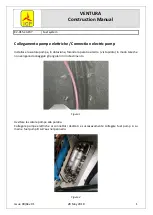
Fast descents
For a quick and efficient way of getting down we recommend, depen-
ding on the situation, the spiral dive or big ears (with or without speed
system) . You should practise fast descents from time to time – so that
they don’t become an emergency when required .
Symmetrical folding of the wingtips (Ears)
To apply this configuration pull the outer, blue marked A lines briskly
down together . This will collapse the wingtips, which will stay folded .
To open them briefly brake both sides .
Caution:
Do not fly spirals or sharp changes of direction wi-
th big ears applied; the increased loading carried by fewer lines
can damage the structure .
Caution:
Be aware that flying with big ears brings the stall clo-
ser . Be careful with the brake lines when big ears are applied,
and do not use this descent method if the wing is wet . See also
section «Flying with a wet paraglider» .
Spiral dive
For the most comfortable way to carry out this manoeuvre we re-
commend a carabiner distance of 40 - 45 cm . Enter the manoeuvre
by progressive increase of a steering demand . Head and field of view
should be directed in the turn direction . Rotation rate, speed and cen-
trifugal force will rise with increasing angle of bank .
Exit from this manoeuvre is carried out with a neutral sitting positi-
on and progressive release of inside brake . Care is essential with the
brake release when recovering from a steep spiral dive of high verti-
cal speed and rotation rate . This judgment is necessary to minimise
the excess energy remaining when the turn stops - which can lead to a
zoom climb and subsequent pitch forward . Be sure to start the recove-
ry with plenty of height remaining above the ground . Generally, the exit
takes the same amount of time as the entry, but the vertical speed will
be much higher – and much more height will be used!
Caution:
Because of the high dynamic and long lines recove-
ry from the spiral must be carried out slowly! Active weightshift
to the inside of the turn causes stronger acceleration and stab-
le rotation . In this case recovery requires active outside brake to-
gether with outside weight shift .
Caution:
The OMEGA XALPS 3 is certified for harnesses in
group GH (without rigid cross bracing) . Harnesses in group GX
(with cross bracing) or those with very low suspension points
can drastically alter the spiral dive behaviour . See section
«Suitable harnesses» .
15
Содержание Omega X Alps 3
Страница 1: ...Edition 2 07_2019 User manual...
Страница 31: ...List of parts Winglet Upper surface Rib Under surface Air intakes Cells 32...
Страница 34: ...Bowline 35...
Страница 35: ...Installation instructions Softlink 36...
















































